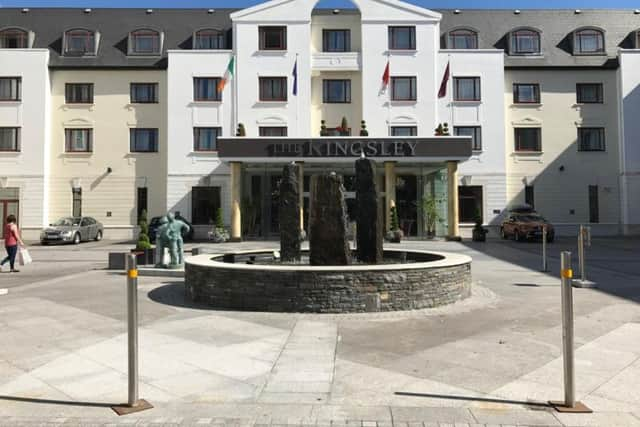Travel: Kissing the Blarney Stone


Situated on the banks of the River Lee in the far south west of the republic, Ireland’s ‘second city’ (after Dublin) has numerous bridges, a wealth of history, interesting places to visit and a laid-back feel that’s almost instantly de-stressing.
I was staying at The Kingsley, a four-star spa hotel a stone’s through from the river bank and an easy, flat 30-minute walk from the city centre.
Advertisement
Hide AdAdvertisement
Hide AdThree separate, stand-alone reception desks in the bright, airy foyer ensured an impressively quick check-in process, accompanied by some jaw-dropping breaking news.


“That was on fire last night!,” the receptionist was indicating towards a huge red-brick building that dominated the skyline on the opposite shore, half its roof and upper floors gutted by what must have been a massive blaze.
“It’s the old asylum and it’s been Kiss the Blarney Stone! empty for a long time. Fortunately, no-one was hurt.”
I could see the charred remains clearly from my spacious, comfortable first-floor room. Next to the burnt-out husk was an even bigger, grey-gabled edifice which has apparently been converted into flats.
Advertisement
Hide AdAdvertisement
Hide AdSufficiently removed from the red-brick pile not to have been affected by the flames, it’s apparently Ireland’s longest building and was once also home to ‘mental’ patients. Who were those poor unfortunates?


According to The Little Book of Cork, people suffering from a range of lunatic anxieties including ‘grief, epilepsy, ‘religious insanity’, nervous depression, want of employment and desertion by a husband or wife’.
Having decided not to hire a car but, instead, to spend three full days exploring on foot and by bus, my first must-do visit was to Blarney, the pretty Irish village world famous for its stone.
Said to endow those who kiss it with the gift of eloquence, the stone turns out to be embedded in the battlement wall of Blarney Castle, a romantic-looking 15th-century tower surrounded by flower-filled gardens, rocky grottoes, weaving pathways and picturesque waterways.
Advertisement
Hide AdAdvertisement
Hide AdKissing it requires queuing (unless you beat the crowds by arriving early or late) climbing more than 120 steep, spiral steps and nerve – if, like me, you’re prone to vertigo and the idea of lying down and tilting your head backwards over a dizzying gap brings on leg-trembling terror. But the challenge doesn’t seem to put people off!


Joining me in the line were Americans, Australians and Swiss – all united in our desire to leave Ireland with the talent of suave rhetoric like fellow Blarney Stone kissers Sir Winston Churchill and Mick Jagger before us.
That cosmopolitan feel Cork and its environs have was echoed when I walked to Cork Gaol the following morning. First opened in 1824 and closed as a prison after the civil war around 100 years later, it stands as an evocative and compelling reminder of just what justice in the past meant and why, for those born poor, punishment was often much harsher.
Our guide had the Irish gift of storytelling and the somber cells and stark corridors, where once speaking was forbidden, were vividly re-imagined through the attraction’s human tales, mannequin-led displays and well-produced video.
Advertisement
Hide AdAdvertisement
Hide AdIn need of a pick-me-up after all that tragedy, my next stop was Midleton, 10 miles east of Cork and the place where Jameson’s whiskey is still made and distributed. I travelled by bus (easily caught in the city centre and, at 7 euros return, very economical).


The old distillery is home to a grand old water wheel that once dominated production, the biggest copper still in the world, enormous iron-bound vats and a vast number of barrels hand-made by coopers. No whiskey tour would be complete, of course, without a tasting or two. My verdict? I’d like another please…
Strange as it might seem, one of the places to see in Cork is the covered English Market. With a history dating back to 1788 when it was first opened, it’s a feast for the eye and stomach with a cornucopia of independent traders selling everything from meat and fish, herbs and spices, chocolates and cakes, cheeses and pasta to crockery and art.
The selection on offer is dazzling and, despite the name, a real tribute to Irish enterprise and traditional culinary know-how. No wonder Rick Stein is quoted as saying: “in my opinion this is the best covered market in the UK and Ireland.”
Advertisement
Hide AdAdvertisement
Hide AdHow to sum up my Cork stay? Fascinating, exciting, full of things to do and, above all, welcoming. Would I go again? In a heartbeat.
Fact File
* Sue Bradbury stayed at the 4-star Kingsley Hotel in Cork on a bed and breakfast basis, the cost from 133 euros per night – http://www.thekingsley.ie/


* Aer Lingus Regional, operated by Stobart Air, fly to Cork from nine destinations; Birmingham, Bristol, Edinburgh, Glasgow, Manchester, Newcastle, Southampton and seasonal routes Newquay and Rennes.
* The airline flies up to 620 flights per week across 26 routes throughout Ireland, the UK and France. For more information visit www.aerlingus.com